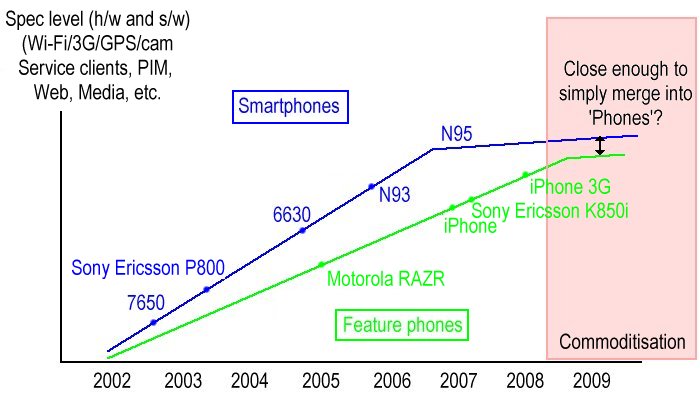In the early days of phones, they were just that, of course. Phones. They made phone calls and then, if you were lucky, let you send text messages as well. Then along came the Nokia 7650 and added a camera and the phone world changed forever. Then along came the Nokia 6630 (among a handful of others) and suddenly stereo music was added to the mix. The N93 added VGA video recording and Wi-Fi. The N95 added a great 5mp camera and GPS.
All milestone, standout products, but their functionality gradually became mainstream, not just in the world of 'official' smartphones but among phones, period. The mainstream catchup isn't complete yet, but it's getting there - and was one of the reasons why my Smartphones Show will become the Phones Show in the near future.

From 2000 to 2008, it has all been about the technology - devices playing catch-up, which gadgets can do which jobs, comparing bullet spec lists, etc. But what happens next, when all devices can do all everything? What's left to do? It's a problem that all the major players are either addressing now or starting to address.
- There's no real point increasing camera capabilities, as we're already on the limit of useful sensor size (without increasing the device's form factor). I daresay that 8mp sensors will appear at some point - to be honest, simply adding Xenon flash to most 3mp and 5mp camera gets them to good enough for 99.9% of uses.
- Wi-Fi plus 3.5G data is already good enough for almost all data-driven uses. 4G (and maybe Wi-Max) data will come along and will improve things further, and of course data coverage will improve in all countries, but we're talking about incremental improvements here. How many fast access points does one person need, after all? Just one that works.
- With GPS in, positioning is accurate to 10 metres or so, good enough for everything from car navigation to buddy finding. There's limited benefit in being accurate down to a metre, so building in Galileo and Differential GPS (for example) doesn't really add anything for most people.
- Storage space is no longer an issue. With 8GB microSD cards at less than £20 in the UK and with 16GB and 32GB upcoming, who on earth can fill these? I keep trying to fill my 8GB card in my N95 and failing. I stuff another 10 albums of music on, another dozen music videos and I check the stats again. Still only half full. Aargghhh!
- Even form factor and user interface are, to an extent, now sorted. S60 3rd Edition with its one-handed non-touch interface is now firmly established as 'familiar', as is Apple's iPhone two-handed finger-driven interface. Both will continue to be tweaked but neither is likely to change significantly, although the latter is, of course, acquiring a large number of imitators. The form factors themselves are gradually converging, too, although there will always be enough variation in styling and detail in order to appeal to a wide enough set of consumers.
So, within a year or two, when every device is polished, has seamless Wi-Fi/3.5G data, has GPS, 5mp camera and all the storage you could ask for, what's left to do? Why should a Nokia N95 8GB owner, for example, 'upgrade' to the latest N98 in 2009 when the N95 still does everything that's asked of it?
This is where services and software comes in. In other words, from this point on it becomes less about what technology is on your phone and more about what you do with your phone.
The likes of Google Mail, Share Online, GooSync, Zyb, Google Maps, Nokia Maps, N-Gage, Jaiku, Twitter and Qik (to name just the top 10 that fell out of my brain) are all software 'services' - i.e. with an optional or compulsory online component - and you can try all of them out today. And they're all, to a degree, free, although data costs and optional upgrades play a part, of course.
Ewan and I have said for years that it's not which phone you have but what you do with it that's important. But then we'd get sucked into the next technology round and we'd prove as succeptible to shiny new toys as the rest of you. But I think we've reached the point where we can stand on our words. I'm currently using the N95, announced in 2006, as my main phone and am very happy with it, it does everything, is small enough to take everywhere and is cheap enough to replace if anything ever happened to it. Ewan's using the N95 8GB, which isn't quite so old (or cheap) but it's basically the same design and spec.
Back in 2006, having a phone that was over a year old meant that you had to put up with a specification that was lacking behind the cutting edge - I contend that this is far less so these days. The phone has become 'commoditised', in that it really doesn't matter much these days whether you use an N95 or an iPhone 3G or a HTC TyTN or a Blackberry Bold - roughly the same application set and the same services will be available to you.
And, although Nokia, Microsoft and Apple (and even perhaps, in the future, Google) will be trying to monetise the add-on services (sync, games, community, etc) that they want to add on to your current specced-out device, the really cool thing is that providing a great new service is something almost anyone can do, so we're back into a wide open world in which anyone can innovate.
And that's got to be good for us all in the long run, no matter who gets our 'service' pounds or 'dollars'.
Steve Litchfield, All About Symbian, 26 June 2008
